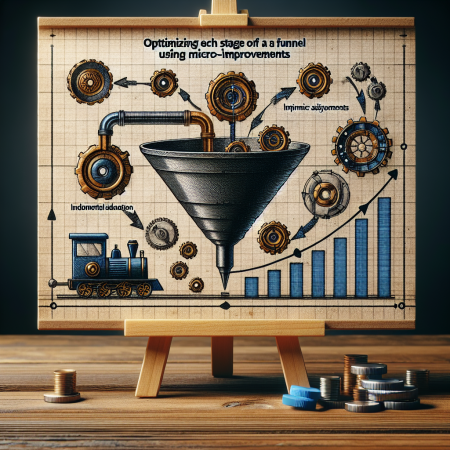Optimize each funnel stage using micro-improvements essential for 2025 automation
Understanding Your Customer’s Journey
Mapping Out The Funnel Stages
One of the first things I learned in my marketing career is that understanding your customer’s journey is paramount. Every customer starts in a different place, often unaware of your product or service’s existence. I make it a priority to map out each stage of the customer journey, from awareness to consideration, and finally to decision. Knowing where your customers fit in this journey allows you to tailor your approach and maximize engagement.
During this mapping process, I often use tools like customer journey maps or flowcharts. These help visualize how potential buyers move through the funnel. It’s unbelievable how much insight you can gain just by stepping back and looking at the bigger picture. This lays the groundwork for identifying micro-improvements later on.
When you continuously refine these stages, you’re not just making surface-level changes; you’re deepening your understanding of your customer, which is where the magic happens. Keep in mind, each micro-improvement can have a ripple effect that transforms the entire funnel.
Enhancing Lead Generation Strategies
Utilizing Targeted Content
Lead generation is one of those areas where you can really get creative. From my experience, targeted content can draw in the right audience like bees to honey. Focusing on creating personas based on your ideal customers enables you to craft content that speaks directly to their needs and interests, and that’s where the leads start pouring in.
One effective strategy is creating blog posts and whitepapers that answer frequently asked questions from your target market. Imagine being the go-to expert on a topic your audience is seeking. That’s your ticket to generating warm leads who are already interested in what you have to say.
Additionally, don’t overlook the power of social media. Utilizing platforms where your audience hangs out helps in attracting leads. A fun, engaging post or even a live chat session can also generate buzz and draw attention to your brand.
Streamlining The Nurturing Process
Implementing Automated Follow-ups
Ah, the nurturing stage—this is where the real relationship building begins. It’s essential to keep the conversation going. From my experience, the best way to do this in our fast-paced world is by implementing automated follow-ups. This is a game-changer! Automation doesn’t mean you lose the personal touch; it means you can deliver timely, relevant content without burning out.
Email drip campaigns are a fantastic tool for nurturing leads. I frequently set up sequences that deliver helpful material tailored to where the lead is in their journey. For example, if they’re just starting to consider a product, I provide them with educational content to help them make informed decisions.
Another tip? Personalize your emails! Using the recipient’s name and mentioning specific insights or interactions can significantly increase open and response rates. Personal touches go a long way in establishing trust and rapport.
Optimizing Conversion Tactics
A/B Testing for Better Results
Now, let’s talk conversions. Making the leap from interested lead to paying customer involves a bit of finesse. This is where A/B testing comes into play. I can’t stress enough how important it is to regularly test different elements of your funnel—headlines, CTA buttons, and even image placements.
In my case, one simple change can sometimes lead to a dramatic increase in conversion rates. For instance, when I tested two different headlines for a landing page, one received a 30% higher conversion rate than the other. And that was just the headline! Imagine the potential gains to be had by consistently testing!
Another tactic is to analyze the user experience. If visitors are bouncing from your page, dig into analytics to find out why. It’s all about creating a seamless experience that guides them to that elusive ‘buy’ button.
Measuring and Analyzing Results
Utilizing Metrics Effectively
Lastly, measurement is critical. In my opinion, nothing beats good analytics. But more than just looking at raw numbers, it’s about gleaning insights to make informed decisions. You have to keep your eye on key performance indicators (KPIs) that matter to each stage of the funnel.
Once I identify KPIs, I set up regular check-ins to ensure everything is performing as expected. Sometimes, a sudden drop in a certain metric signifies a need for a course correction, and being proactive about this can save you from larger problems down the line.
Remember to involve your team in these discussions as well. Fresh perspectives can surface new ideas for optimization that you might have overlooked. Together, we can dig deeper into the data to shape the future of our marketing strategies effectively.
Frequently Asked Questions
1. What are micro-improvements?
Micro-improvements are small, incremental changes made to various stages of the marketing funnel that can lead to significant enhancements in overall performance.
2. Why is mapping out funnel stages important?
Mapping funnel stages helps you understand your customers’ journey and tailor your strategies accordingly, which is vital for effective engagement.
3. How can I improve lead generation?
Improving lead generation often involves creating targeted content that resonates with your audience, utilizing social media, and being active in niche communities.
4. What role does automation play in nurturing leads?
Automation streamlines the nurturing process by allowing you to send personalized follow-ups and maintain communication without overwhelming yourself.
5. How do I measure the success of my funnel optimizations?
You can measure success through key performance indicators (KPIs) specific to each stage of your funnel, analyzing trends, and adjusting strategies accordingly.
Related Content
- The Best Payment Processors for Online Coaches
- Retain user interest with hyper-relevant push notifications perfected for 2025
- How to Use Google Analytics to Track Your Online Business Performance
- The Best Ways to Promote Affiliate Products on Instagram
- The Marketing Automation Sequence That Runs My Business While I Sleep


